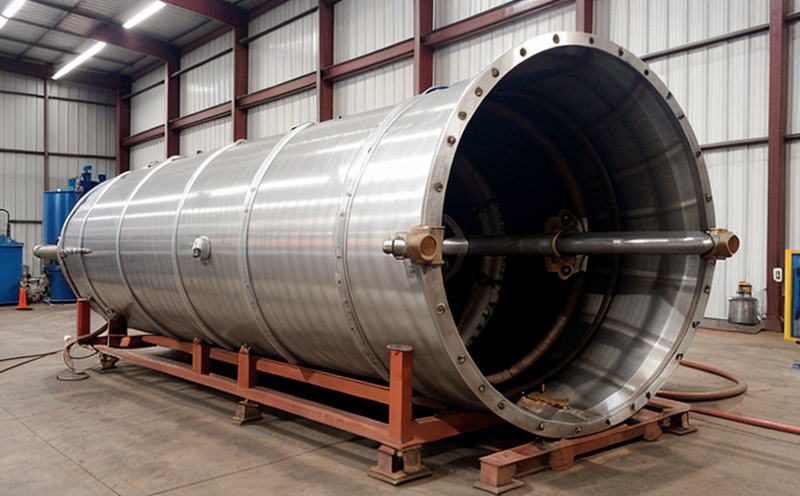Pressure vessel hydrostatic pressure inspection
The process of inspecting and testing pressure vessels using a hydrostatic pressure test is crucial to ensuring safe operation in industries ranging from petrochemicals to pharmaceuticals. A hydrostatic pressure test, also known as a hydraulic or water pressure test, involves filling the vessel with liquid under controlled conditions to assess its integrity. The procedure is designed to identify any potential flaws or weaknesses that could lead to failure during normal operational pressures.
This type of inspection is particularly relevant for vessels operating at high temperatures and pressures where even minor defects can result in catastrophic failures. Compliance with international standards such as ISO 5703 ensures that the test meets stringent safety requirements.
The process begins by thoroughly cleaning the vessel to remove any dirt or debris which might interfere with accurate testing. Once cleaned, the vessel is filled with water and pressurized slowly until it reaches a specified level of hydrostatic pressure. The pressure is then held for an extended period to allow any defects to become visible. If no leakage or other signs of failure are observed after this holding time, the test is considered successful.
One critical aspect of a hydrostatic pressure test is ensuring that the vessel can withstand the specified working pressures without issue. This requires precise calibration and control over both temperature and pressure during testing to prevent overstressing the material. Additionally, it’s important for operators to consider the environmental factors affecting the vessel, such as corrosion rates and stress-corrosion cracking tendencies.
Another key factor is the choice of liquid used in the test. Water is typically preferred due to its availability and lower cost compared to other fluids like oil or glycol. However, certain applications may require different liquids based on specific industry needs or regulatory requirements.
The inspection itself involves close monitoring by qualified personnel who look for any signs of leakage or deformation that could indicate structural integrity issues. Any detected defects would need immediate attention and repair before the vessel can return to service.
Post-inspection, a detailed report is generated summarizing all aspects of the test including pressure levels achieved, duration held at those pressures, observations made during monitoring, and conclusions drawn regarding the vessel's condition.
Scope and Methodology
| Test Parameter | Specification | Description |
|---|---|---|
| Temperature Range | -40°C to 150°C | This covers a wide range of operating conditions encountered in various industries. |
| Pressure Levels | Up to 250 times the design pressure | To ensure that any potential weaknesses are identified under extreme stress. |
| Holding Time | At least 10 minutes at specified pressure | This allows sufficient time for any defects to manifest themselves visually or through instrumentation. |
| Liquid Type | Clean potable water unless otherwise specified | To avoid contamination and ensure accurate results. |
| Instrumentation | Pressure gauges, temperature sensors, leak detection devices | For real-time monitoring of all critical parameters during the test. |
| Documentation | Detailed report including pressures applied, holding times, observations made | To provide a comprehensive record for future reference and compliance verification. |
| Personnel Qualifications | ASME-certified inspectors or equivalent | To ensure that the inspection meets international standards of quality and reliability. |
International Acceptance and Recognition
The hydrostatic pressure test is widely recognized across many countries as a critical component in ensuring the safety of pressure vessels. It aligns with several international standards including ISO 5703, ASME Section VIII Division 1, and EN 14285, among others.
In particular, ASME Section VIII Division 1 provides detailed guidelines for conducting these tests on unfired pressure vessels used in the manufacture of boilers and pressure vessels. Compliance with this standard ensures that inspections are performed consistently across different regions while meeting high safety standards.
Similarly, EN 14285 establishes harmonized European regulations covering the design, construction, inspection, testing, operation, maintenance, modification, decommissioning, and disposal of unfired pressure vessels. Adherence to these guidelines provides assurance that all parties involved understand their responsibilities clearly, promoting safer practices within the industry.
These global standards not only help maintain consistency but also foster collaboration between countries by providing common benchmarks against which performance can be measured. As such, they play a vital role in advancing the field of pressure vessel technology worldwide.
Environmental and Sustainability Contributions
The hydrostatic pressure test contributes positively to environmental sustainability through several means. By ensuring that pressure vessels operate safely and efficiently, it reduces risks associated with leaks or failures which could lead to hazardous substances being released into the environment.
In addition, adhering strictly to international standards helps minimize waste by preventing premature replacements of perfectly good equipment due to substandard inspections. This extends the useful life of assets, thereby reducing resource consumption over time.
Moreover, conducting thorough inspections encourages continuous improvement in design and manufacturing processes, leading to more robust vessels that require fewer repairs and maintenance throughout their lifetimes. Such improvements also contribute towards reducing carbon footprints associated with production cycles and transportation needs.





